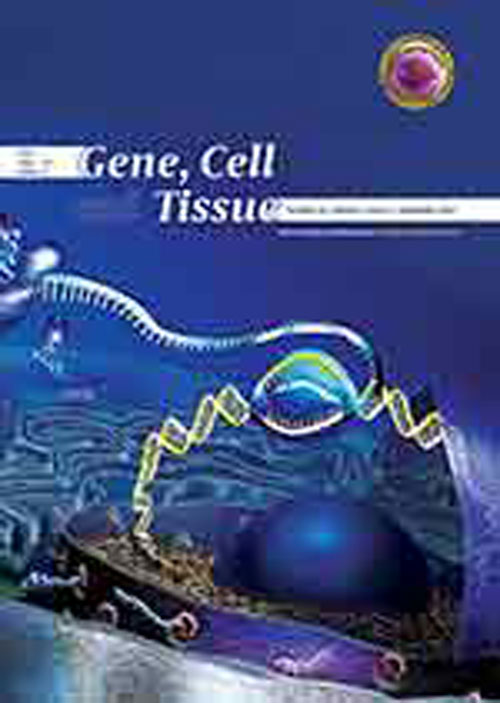فهرست مطالب

Gene, Cell and Tissue
Volume:5 Issue: 1, Jan 2018
- تاریخ انتشار: 1396/12/25
- تعداد عناوین: 7
-
-
Page 1Systemic Lupus Erythematosus (SLE) is a chronic human autoimmune disease, which is characterized by increased activity of B cells and production of antibodies against tissue antigens. It engages many tissues and organs, including joints, kidneys, heart, and the nervous system. Although the exact pathogenesis of SLE remains to be elucidated, it is suggested that genetic background plays a paramount role in SLE etiology. Increasing evidence is indicating an important role for interleukins in progression of SLE. Interleukins are a group of cytokines secreted by T helper cells, monocytes, macrophages, and B cells, which are involved in growth and differentiation of T and B cells. The expression level of interleukins is influenced greatly by genetic composition. Therefore, some polymorphisms can control the expression of interleukins. Consequently, genetic studies can shed light on our understanding of SLE nature. Therefore, in the present study, the researchers reviewed the roles of eight key interleukin polymorphisms and their effects on SLE pathogenic.Keywords: Interleukin, 1, Cytokines, Systemic Lupus Erythematosus, Polymorphism
-
Page 2BackgroundNigella sativa grain has a rich medical and religious history and consists of powerful chemical compounds that can have many effects on human health. In this study the effect of ethanolic extract of Nigella sativa on antioxidant properties has been investigated.MethodsThe present study was carried out on 28 adult female Wistar rats (weighing 160 - 200 g) in 4 groups (7 mice per group). The 1st group (control group) received no treatment, the 2nd and 3rd groups were treated orally with alcoholic extract of Nigella sativa, at a dose of 400 mg / kg of body weight for 21 days. In addition to oral treatment, the 3rd group was also treated with immobilization stress, and the 4th group was only given immobilization stress. Malondialdehyde (MDA), Ferric Reducing / Antioxidant Power (FRAP) and Catalase (CAT) were measured in liver and kidney. Furthermore, the fatty acids profile of the extracted oil was studied. In addition, the proximate chemical composition and the contents of Calcium and phosphorous of Nigella sativa L. seeds was investigated to 5 times. The results of the study were analyzed using one-way ANOVA and mean comparison was conducted using Tukeys test at significance level of (PResultsThe results showed Nigella sativa to be rich in fatty acids, especially linoleic, oleic, palmitic, stearic, and linolenic acids were amounting (46.05 ± 1.3, 33.46 ± 1.02, 15.05 ± 0.65, 3.46 ± 0.13, 1.98 ± 0.04%, respectively. PConclusionsThe results of this study show that extract of Nigella sativa to have necessary chemical characteristics increases antioxidant capacity. Moreover, reduces lipid peroxidation (Oxidative stress) and also the harmful effects of stress on the bodys tissues.Keywords: Alcoholic Extraction, Catalase, Antioxidant Capacity, Lipid Peroxidation, Stress
-
Page 3BackgroundThe overgrowing resistance of the species of candida toward anti-fungus drugs has necessitated the use of compounds with antifungal features. Some plants have antimicrobial features due to their polyphenols components. This paper aims at exploring the anti-fungus effects of Zataria multiflora against Candida albicans.MethodsA total of 20 g of the dried and pounded leaves of the Zataria multiflora was used and its extract was prepared in the rotary device. Various concentrations of all extracts were prepared in the 96 cell microplate. MIC and diameter of the inhibitory shield were measured by dilution method and agar disk, respectively.ResultsThe Zataria multiflora extract showed good antifungal effects against Candida albicans sample. Therefore, this plant extract can replace chemical drugs and be used against candida-caused infection upon completion of this research trend.ConclusionsIn the present study the principles of the extract, different methods of minimum inhibitory concentration (MIC), and mode of action of the extract are discussed.Keywords: Antifungal Effects, Extract, Zataria multiflora, Candida albicans
-
Page 4BackgroundMicroRNAs (miRNAs) play significant roles in several physiological procedures such as embryo implantation. Recently, findings have indicated that aberrant miRNAs gene expression and single nucleotide polymorphism in the gene encoded miRNAs may be contributed to the pathogenesis of recurrent pregnancy loss (RPL). This investigation aimed to examine potential associations between the two precursor miRNA SNPs miR-196a2 T > C and miR-499 A > G and susceptibility to RPL.MethodsWe were analyzing a total of 200 subjects, which consisted of 100 women who experienced three or more recurrent miscarriages and 100 healthy women with one child and without historical aberrations. The genotypic frequencies of two SNPs were analyzed by polymerase chain reaction-restriction fragment length polymorphism (PCR-RFLP) technique to assess the association between the presence miRNA gene variant with the risk of RPL.ResultsThe genotypes frequency of miR-499 gene polymorphism AA/AG GG and GG/AG AA showed a statistically significant association with the risk of RPL (P = 0.019; OR = 2.003; 95% CI, 1.116 - 3.594) and (P = 0.024; OR = 2.100; 95% CI, 1.095 - 4.025), respectively. The genotypes frequency of miR-196a2 gene polymorphisms did not reveal a statistically significant difference across the two groups (P > 0.05).ConclusionsOur findings proposed that nucleotide changes in miR-499 gene encoding region may be contributed as a genetic predisposition factor to RPL, whereas the miR-196a2 gene variation cannot be a negative effect on pregnancy outcome.Keywords: MicroRNAs, Recurrent Pregnancy Loss, SNP, RPL, miR, 196a2, miR499

